Abstract
An international study was performed to investigate the discrepancy between physician and population perception of the management of musculoskeletal pain (MP). One thousand, one hundred and fifty-four people with MP and 604 primary care physicians randomly selected from six countries (UK, Germany, Italy, France, Australia and Mexico) were interviewed by telephone. The interviews were based on structured questionnaires that captured: the management of pain, knowledge about the condition, sources of information, information communicated within the consultation, and patient roles in pain management. People with MP are confused about the different treatment options available (up to 63% out of N = 1,154) to them and their relative benefits and risks (33–51%). Doctors are the most valued and appropriate source of information (by up to 80% of people, N = 1,154) but are difficult to access. When people do have a clinical consultation, there may be a disparity between the information doctors convey and patient recall of the information provided. For example, most doctors tell patients the number of tablets they will need to take to achieve optimal pain relief, but only 34–63% of people with MP recall being given this information. Lack of information may partially explain why so few people (7–36%) return to their doctor when their prescribed medication is ineffective. This survey identified lack of information as a potential barrier to effective treatment. Physicians’ perceptions that people with MP are not able to appraise all the information and may prefer a passive role in their care need to be challenged if patients are to be participants in the management of their condition.

Similar content being viewed by others
References
White KP, Harth M (1999) The occurrence and impact of generalised pain. Balliere’s Clin Rheumatol 13:379–389
Woolf AD, Akesson K (2001) Understanding the burden of musculoskeletal conditions. The burden is huge and not reflected in national health priorities. Br Med J 322:1079–1080
World Health Organisation (2003) Burden of musculoskeletal conditions at the start of the new millennium. WHO Scentific Report, Technical Report Series no. 919. WHO, Geneva
Woolf AD (2000) The bone and joint decade 2000–2010. Annals Rheum Dis 59(2):81–82
World Health Organisation (1988) Health 21: the health for all policy for the WHO European region – 21 targets for the 21st century. WHO Regional Office for Europe, Copenhagen
Woolf AD, Zeidler H, Haglund U, Carr AJ, Chaussade S, Cucinotta D, Veale DJ, Martin-Mola E, on behalf of Arthritis Action Group (2004) Musculoskeletal Pain in Europe: its impact and a comparison of population and medical perceptions of treatment in eight European countries. Ann Rheum Dis 63:342–347
Arthrits Care (2006) OA nation. www.arthritiscare.org.uk, accessed 03.11.06
Sakalys JA (1997) Illness behaviour in rheumatoid arthritis. Arthritis Care Res 10:229–237
Goodwin JS, Black SA, Satish S (1999) Aging versus disease: the opinions of older black, Hispanic and non-hispanic white Americans about the causes and treatment of common medical conditions. J Am Ger Soc 47:973–979
Anderson JL, Dodman S, Kopelman M, Fleming A (1979) Patient information recall in a rheumatology clinic. Rheum Rehabil 18:18–22
Tuckett DA, Boulton M, Olson C (1985) A new approach to the measurement of patients’ understanding of what they are told in medical consultations. J Health Soc Behav 26:27–38
Donovan JL, Blake DR, Fleming WG (1989) The patient is not a blank sheet: lay beliefs and their relevance to patient education. Br J Rheumatol 28:58–61
Britten N, Stevenson FA, Barry CA, Barber N, Bradley CP (2000) Misunderstandings in prescribing decisions in general practice: qualitative study. Br Med J 320:484–488
Woloshil KK, Ruffin MT 4th, Gorenflo DW (1994) Patients’ interpretations of qualitative probability statements. Arch Fam Med 3:961–966
Horne R, Weinman J (1999) Patients’ beliefs about prescribed medicines and their role in adherence to treatment in chronic physical illness. J Psychosom Res 47:555–567
Conrad P (1985) The meaning of medications: another look at compliance. Soc Sci Med 20:29–37
Kahneman D, Tversky A (1984) Choices, values and frames. Am Psychol 39:341–350
Donovan JCL, Blake DR (1992) Patient non-compliance: deviance or reasoned decision-making. Soc Sci Med 34:507–513
ARMA (2006) ARMA standards of care for people with osteoarthritis. www.arma.uk.net, accessed 03.11.06
People with Arthritis and Rheumatism living in Europe (PARE). PARE manifesto. www.paremanifesto.org, accessed 03.11.06
Funding
Arthritis Action Group (AAG) is an independent group of specialist physicians and academics, developed with support from Pfizer in 2001. AAG acknowledges that this survey was conducted with support from Pfizer. AAG retains complete control over study design, data analysis and communication of results.
Authors and contributors
AD Woolf was involved in the design of the study, interpretation of the results, drafting and revising the paper and approving the final version for publication. J Frohlich, M Guslandi, B Michel and H Zeidler were involved in the interpretation of the results, revising the paper and approving the final version for publication. AJ Carr was involved in the design of the study, analysis of the data, interpretation of the results, drafting and revising the paper and approving the final version for publication. The other members of the Arthritis Action Group: Dr. A Aly, Dr. N Amin, Professor P Bertin, Dr. Bolten, Professor Chaussade, Professor Cucinotta, Professor Haglund, Dr. Martin Mola, Dr. Rahmen and Dr. Veale were actively involved in the review and interpretation of the data and approved the final version of the paper for publication.
Conflict of interest
None.
Author information
Authors and Affiliations
Consortia
Corresponding author
Rights and permissions
About this article
Cite this article
Woolf, A., Carr, A., Frolich, J. et al. Investigating the barriers to effective management of musculoskeletal pain: an international survey. Clin Rheumatol 27, 1535–1542 (2008). https://doi.org/10.1007/s10067-008-0965-2
Received:
Revised:
Accepted:
Published:
Issue Date:
DOI: https://doi.org/10.1007/s10067-008-0965-2




